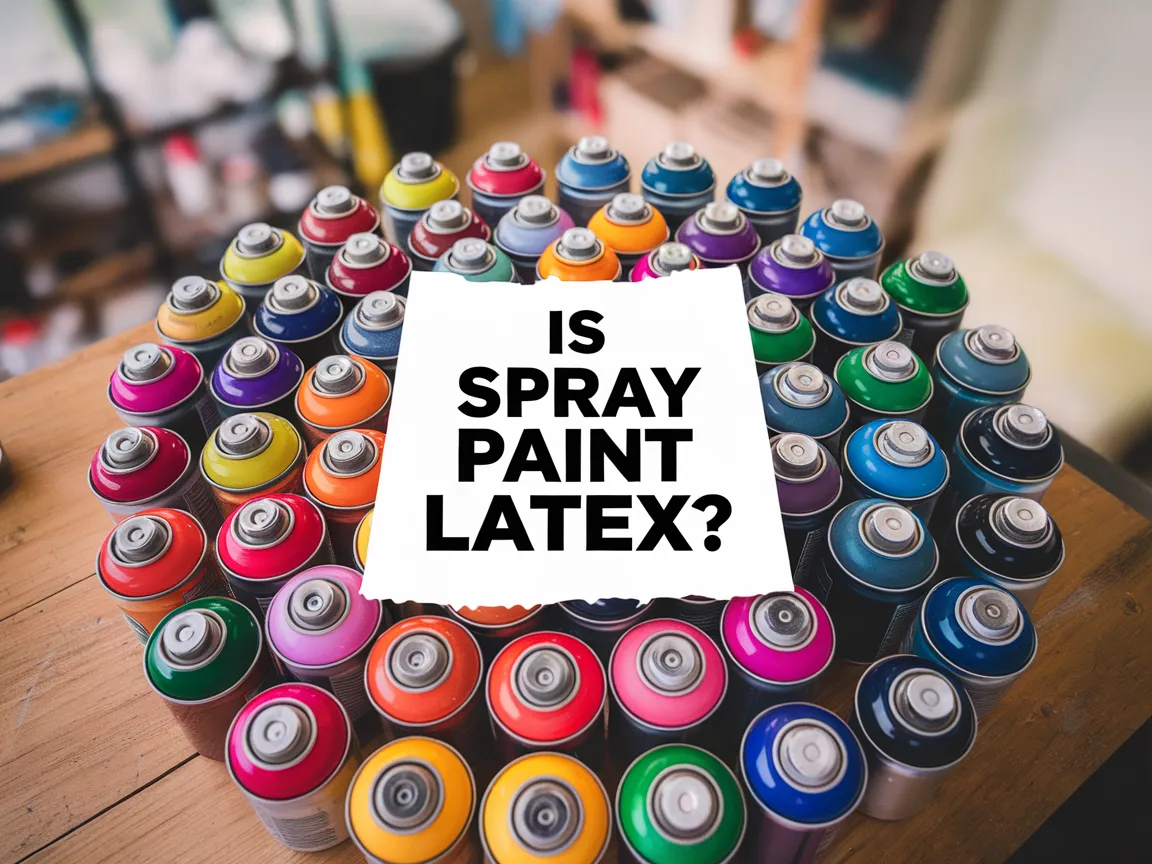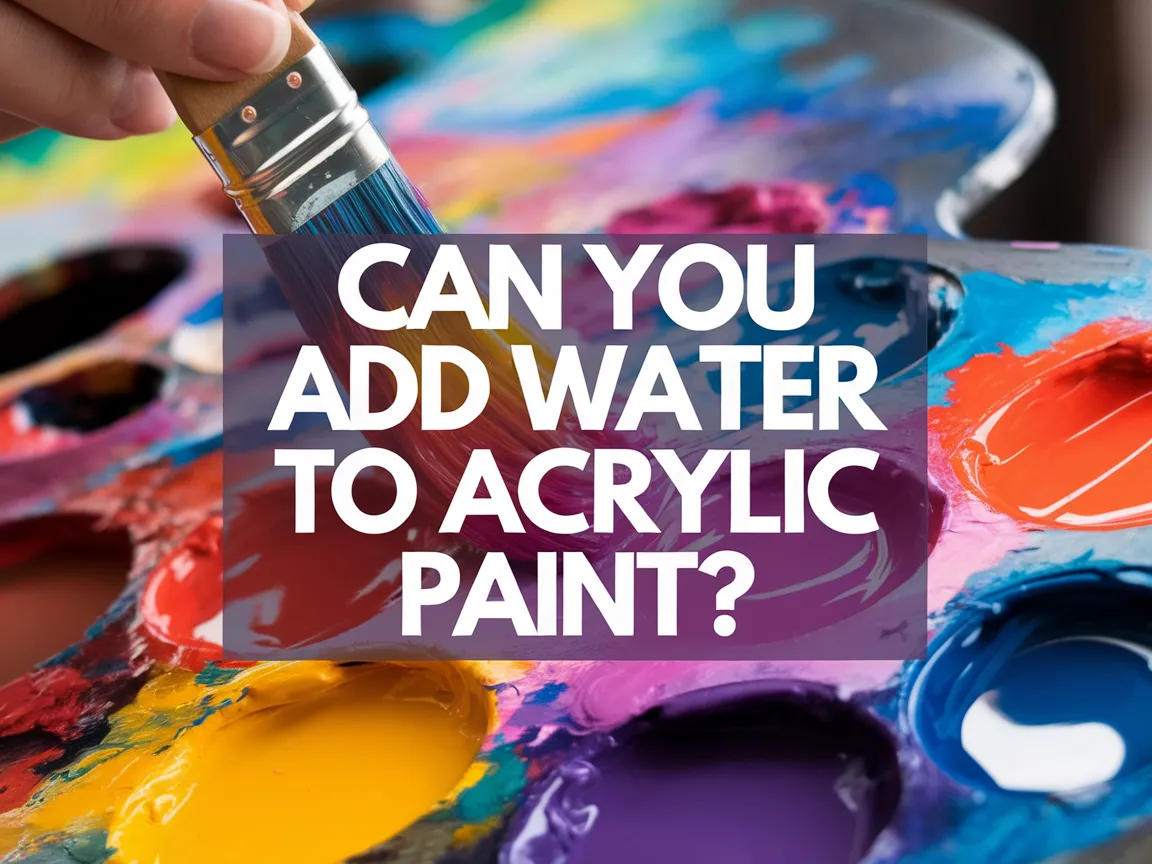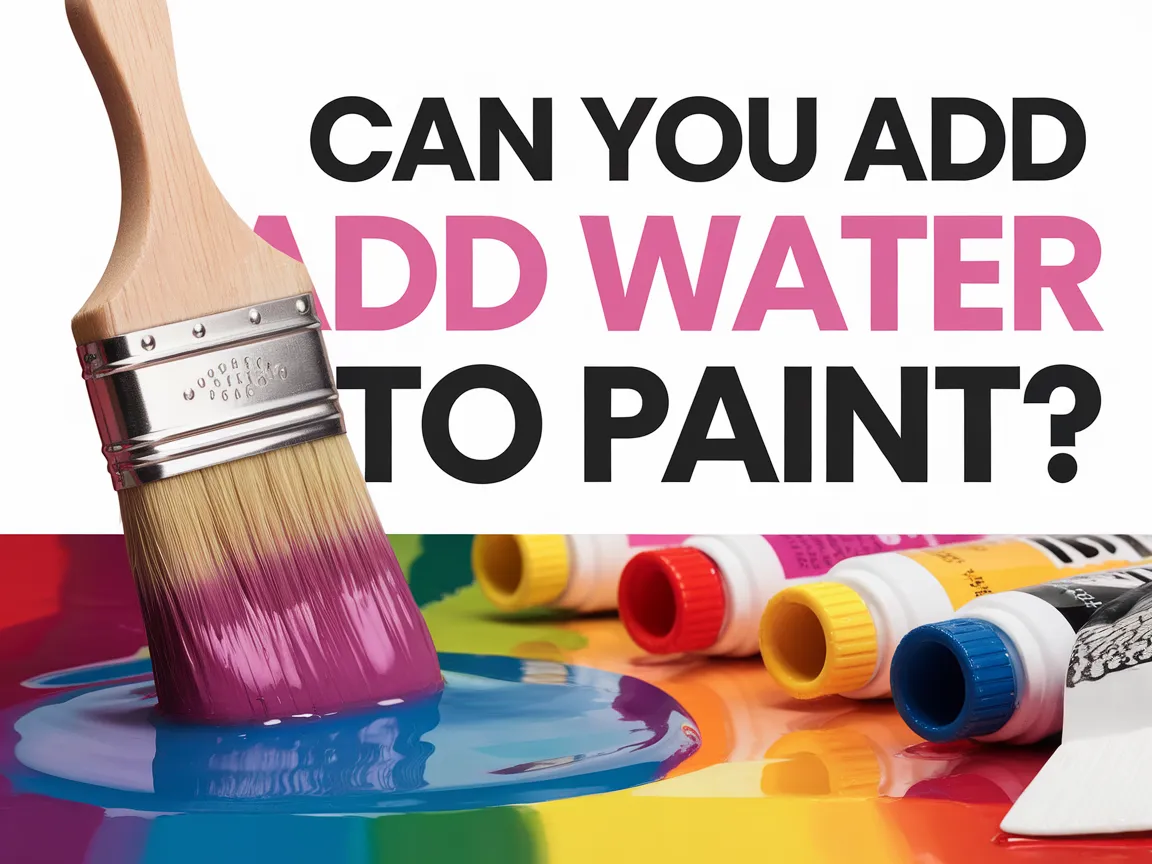Can You Use Acrylic Paint Outside?
Published on: March 25, 2025 | Last Updated: January 7, 2025
Written By: Alisha Winters
Acrylic paint is a type of paint made from tiny plastic bits mixed with water. It dries quickly and can become shiny or matte, like magic!
So, can you use acrylic paint outside? It’s important to know because the weather can affect how your art turns out. I once painted a chair outside, and it got rained on before it dried; what a mess!
In this guide, you’ll learn about important considerations before starting outdoor painting, steps for using acrylic paint outdoors, types of paint suitable for the outdoors, and common issues to watch out for. Plus, I’ll share creative DIY project ideas using acrylics, and you’ll even discover how to make hot pink acrylic paint or how to get off acrylic paint if needed!
Contents
- 1 Can You Use Acrylic Paint Outside?
- 2 What is Acrylic Paint?
- 3 Important Considerations Before You Start Outdoor Painting
- 4 Steps to Use Acrylic Paint Outdoors
- 5 Recommended Color Palette for Outdoor Acrylic Paint Projects
- 6 Types Of Acrylic Paint Suitable for Outdoor Use
- 7 Factors Affecting Outdoor Acrylic Painting Success
- 8 Common Issues When Using Acrylic Paint Outside
- 9 Finishing Touches for Outdoor Acrylic Paint Projects
- 10 Creative DIY Project Ideas Using Acrylics Outdoors
- 11 Optimal Techniques for Using Acrylic Paint Outdoors
- 12 Choosing the Right Sealer for Outdoor Acrylic Projects
- 13 Frequently Asked Questions About Using Acrylic Paint Outside
- 14 Conclusion
- 15 Useful Resources
Can You Use Acrylic Paint Outside?
Yes, you can use acrylic paint outside! It’s water-resistant once dry, but you’d want to use a UV-resistant sealant for outdoor pieces. This helps protect your art from fading in the sun. Remember, temperature below 50°F (10°C) can slow drying time. If you’re looking to enhance your outdoor painting techniques, painting multiple accent walls can provide additional creative inspiration.
The Finishing Touch
A freshly painted wall is a blank canvas. The best way to bring your room to life is with a single piece of statement art that ties everything together.
Browse Wall Art at Big Wall DecorWhat is Acrylic Paint?
Acrylic paint is a fast-drying paint made from pigment suspended in a synthetic polymer emulsion. It typically dries within 30 minutes, allowing artists to quickly apply multiple layers. It comes in various formulations, including heavy body, soft body, and fluid acrylics. Researchers have long been fascinated by the historical evolution of painting techniques, with some even exploring ancient prehistoric cave painting methods.
Now, let’s discuss the challenges of using acrylic paint outdoors. When I tried outdoor painting, I faced several weather issues, like humidity affecting drying times. This made me question the durability of acrylics in harsh conditions. If you’re worried about potential paint damage, you might want to explore how chemicals impact paint surfaces.
I had a friend who relied on it for her mural projects—she extensively used acrylics on external walls. She reinforced her work with a clear coat to enhance UV (Ultraviolet) resistance and water exposure, ensuring her art lasted longer outdoors. It’s essential to consider how acrylic paint performs outside; environmental factors significantly impact the vibrant world of art. If you’re curious about exploring unique artistic techniques like creative diamond painting methods.
Important Considerations Before You Start Outdoor Painting
What do you need to succeed?
- Quality Acrylic Paint: Choose brands like Golden Heavy Body or Liquitex Basics. They provide better UV resistance for outdoor durability.
- Topcoat or Sealer: Use products like Mod Podge Outdoor or Rust-Oleum Outdoor for weather protection.
- Paint Brushes: Invest in a variety, such as synthetic watercolor brushes and stiff bristle brushes by Winsor & Newton, for different textures.
- Drop Cloths: Use large, absorbent drop cloths like Heavy-Duty Canvas to keep your workspace clean.
- Water Container: Have a large bucket (About 3 Liters/0.8 Gallons) for rinsing brushes and staying hydrated.
We have now covered key factors to consider before beginning outdoor painting. The next section discusses how to use acrylic paint outdoors.
Also See: Can Resin Be Painted? Tips for Stunning DIY Projects!
The Finishing Touch
A freshly painted wall is a blank canvas. The best way to bring your room to life is with a single piece of statement art that ties everything together.
Browse Wall Art at Big Wall Decor
Steps to Use Acrylic Paint Outdoors
Here’s how to successfully paint with acrylics outside.
-
Selecting the Right Surface for Outdoor Acrylic Painting
Choose surfaces like wood, canvas, or masonry for your acrylic work. Sand wood smooth, and prime canvas to prevent water absorption.
These surfaces ensure that your paint adheres well and lasts longer. Some surfaces may need a specific primer; check compatibility before you start.
-
Preparing the Area for Outdoor Painting
Clear the area of dirt, rocks, and debris—you don’t want anything ruining your masterpiece! A flat, stable surface is important, so lay down tarps or boards as needed.
If there are herbs or plants nearby, protect them with covers or relocate them. Planning your setup helps you focus on your art!
-
Choosing the Right Weather for Painting
Paint on clear, dry days with moderate temperatures—ideally between 15°C and 30°C (59°F and 86°F). High humidity can slow drying, while extreme heat or cold can crack or warp your work.
Always check for rain on the way! I’ve had to redo entire projects just because I didn’t notice a storm front approaching.
-
Applying Acrylic Paint Outdoors: Techniques and Tips
Start with a thin base layer to improve coverage. Use sweeping strokes to evenly distribute the paint; avoid making it too thick to prevent cracking.
If you’re painting in direct sunlight, lightly mist the area with water. This keeps your paint moist longer for smoother application!
We’ve wrapped up the steps for using acrylic paint outdoors. Let us turn our attention to the suggested color palette.
Recommended Color Palette for Outdoor Acrylic Paint Projects
I recommend a “Nature’s Embrace” theme for your outdoor acrylic paint projects because it captures the calming essence of nature with colors that blend beautifully together.
| Color Box | Hex Code | Color Name |
|---|---|---|
| #4CAF50 | Leafy Green | |
| #FFD700 | Sunshine Yellow | |
| #1E90FF | Sky Blue | |
| #8B4513 | Earthy Brown |
We covered the suggested color palette for outdoor acrylic paint projects. We will now cover types of acrylic paint suitable for outdoor use.
Types Of Acrylic Paint Suitable for Outdoor Use
Let’s discuss the different types: Heavy Body, Soft Body, Acrylic Gouache, and Outdoor Acrylics.
-
Heavy Body Acrylic
Heavy Body Acrylic paints are thick and provide a rich texture. They dry to a semi-gloss finish and hold their shape well, making them ideal for outdoor murals.
-
Soft Body Acrylic
Soft Body Acrylics flow easily and are great for detailed brushwork. They can be used outdoors, but protect them from extreme weather.
-
Acrylic Gouache
Acrylic Gouache combines the qualities of acrylic paint with a matte finish. It’s great for fine arts but can lift under heavy rain, so use caution outdoors.
-
Outdoor Acrylics
Outdoor Acrylics are specially formulated to resist UV light and harsh weather. They provide long-lasting color retention, making them perfect for outdoor projects.
This reminds me of a valuable lesson I learned while testing Outdoor Acrylics. They really do make a difference; my colors stayed vibrant while everything else faded!
You should now have a good understanding of outdoor acrylic paint types. In the next part, we’ll discuss factors for successful outdoor painting.

Factors Affecting Outdoor Acrylic Painting Success
What factors influence using acrylics outdoors? A lot more than you’d think!
-
Temperature: High heat can dry acrylic paint too quickly, affecting blending and finish.
-
Humidity: Excess moisture slows drying time, causing unwanted color mixing.
-
Sunlight: Direct sunlight can fade colors and make surfaces sticky. Use shade when possible.
-
Surface Type: Rough or porous surfaces absorb paint. Smooth surfaces yield better results.
Common Issues When Using Acrylic Paint Outside
My friend once tried using acrylic paint outdoors. Faced with wind and sudden rain, her artwork turned into a muddy mess!
To fix it, she applied a UV-resistant varnish after the paint dried completely (About 24 Hours). This saved her vibrant colors from fading in sunlight and helped resist moisture.
Finishing Touches for Outdoor Acrylic Paint Projects
After applying acrylic paint outdoors, wait 30 days before using a UV-resistant sealer, like Clear Matte Spray by Krylon, to enhance durability against sun exposure.
Inspect your paint for wear after six months. Check for peeling or fading by sliding a finger across the surface to feel for raised edges, using exact measurements if needed.
The Finishing Touch
A freshly painted wall is a blank canvas. The best way to bring your room to life is with a single piece of statement art that ties everything together.
Browse Wall Art at Big Wall DecorNow, with experience, consider trying a spray cooling method to extend drying times during heat waves (Above 30°C/86°F), adding a unique finish to your art.
Creative DIY Project Ideas Using Acrylics Outdoors
How about creating vibrant flower pots or unique outdoor furniture? Imagine painting those plain pots with funky designs or turning an old chair into a colorful garden statement piece!
To start, grab some outdoor acrylic paint, stencils, and brushes. For about $30-$50, you can tackle both projects in a fun weekend – around 4-6 hours for flowers and about 8 for furniture, depending on how detailed you wanna get! Artists and hobbyists have discovered fascinating ways to explore creativity beyond traditional techniques, including unique animal painting methods.
Now, if you’re asking, “can you use acrylic paint outside?”, absolutely! Just seal it with a good outdoor varnish to withstand the elements. Or, you could create some DIY weather-resistant paint by mixing your acrylic with sand; it produces a textured effect that’s super cool and protective! If you’re curious about alternative painting techniques like diamond painting drill methods, there are fascinating creative options to explore beyond traditional painting.
Optimal Techniques for Using Acrylic Paint Outdoors
Let’s dive into some techniques that can elevate your outdoor painting experience!
Layering for Depth
Layering your paint can add dimension to your art. Start with a base color, and let it dry completely before applying additional layers. This technique takes advantage of acrylics’ quick drying time. If you’re working with 3D printed objects, you’ll want to explore painting mediums.
Using Texture Mediums
Add texture to your paintings by mixing in mediums. Try using sand, modeling paste, or gel mediums. These materials create a more engaging surface that captures light beautifully.
Dry Brushing Technique
This technique involves using a dry brush with minimal paint. Lightly swipe it across the surface to create soft highlights or suggest textures like fur or grass.
Choosing the Right Sealer for Outdoor Acrylic Projects
A good sealer is key for long-lasting outdoor art. Here’s what to know.
- Water-based Sealers: Ideal for light protection and easy cleanup. Look for products like Liquitex or Golden.
- UV Protective Sealers: Essential in sunny areas. They help prevent fading. Brands like Krylon offer excellent options!
- Weather-Resistant Sealers: These guard against moisture. Use products designed specifically for outdoor use.
Frequently Asked Questions About Using Acrylic Paint Outside
Now let us look at some common questions I typically get asked.
Can Acrylic Paint Withstand Rain Once Dry?
Yes, acrylic paint can withstand rain once dry. Generally, it takes about 24 hours for acrylic paint to cure properly, depending on humidity and temperature.
What Surfaces Can I Use Acrylic Paint on Outdoors?
You can use acrylic paint on various surfaces outdoors, including canvas, wood, metal, and stone. Each material offers a different texture, influencing the final outcome of your work.
How Long Does Acrylic Paint Take to Dry Outdoors?
Acrylic paint typically takes 20 to 30 minutes to dry to the touch outdoors. However, make sure to consider factors like temperature and airflow that can also affect drying time.
Can I Seal Outdoor Acrylic Paint?
Yes, you can seal outdoor acrylic paint. Using a clear acrylic sealer helps protect your painting from UV rays and moisture, increasing its durability and longevity.
Is Acrylic Paint Eco-friendly for Outdoor Use?
Yes, acrylic paint is generally considered eco-friendly. Many brands use water-based formulas low in volatile organic compounds (Vocs), making them safer for the environment.
How Can I Make Acrylic Paint More Opaque?
You can make acrylic paint more opaque by adding a heavy body medium or mixing it with white or a complementary color. This enhances coverage, especially on darker surfaces.
How to Get Acrylic Paint Off Skin or Surfaces?
To get acrylic paint off skin or surfaces, simply wash with soap and water while it’s still wet. If dried, rubbing alcohol or a dedicated paint remover is the best solution.
How to Mix Brown Acrylic Paint?
To mix brown acrylic paint, blend primary colors red, yellow, and blue. Adjust the ratios for different shades, adding black for a richer tone or white for a lighter shade.
Conclusion
We covered key topics like what acrylic paint is, important considerations, steps for outdoor use, recommended color palettes, types suitable for outdoor conditions, factors for success, common issues, finishing touches, and creative DIY project ideas.
So, can you use acrylic paint outside? Yes, with the right type and techniques—like picking outdoor-specific acrylics and knowing your weather. You can definitely create vibrant art that lasts.
For further insights and tips, visit Paint Answers.
Useful Resources
- Betti, C., & Sale, T. (2012). Drawing: A Contemporary Approach (6th ed.). Belmont, CA: Cengage Learning.
- Outdoor Acrylic Paint by Craft Smart®, 2oz. – Michaels
- Can you use acrylic paint on wood if you want it to be outside? – Quora
- Acrylic vs. outdoor acrylic
Experienced interior designer with 15+ years in transforming spaces, blending artistry with expertise in color and design. Rhode Island School of Design graduate, specializing in restorations and modern makeovers.
Acrylic, Medium









